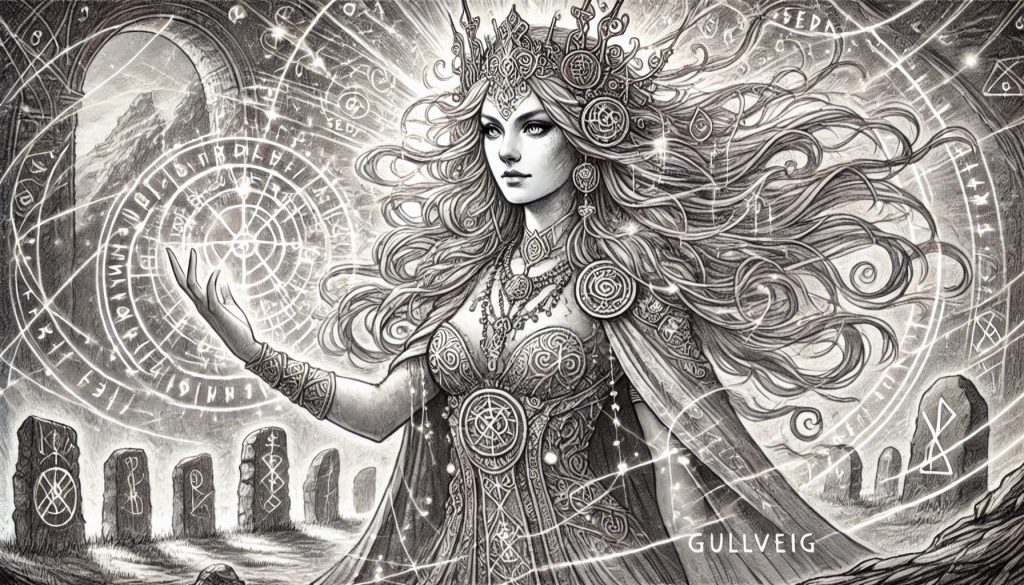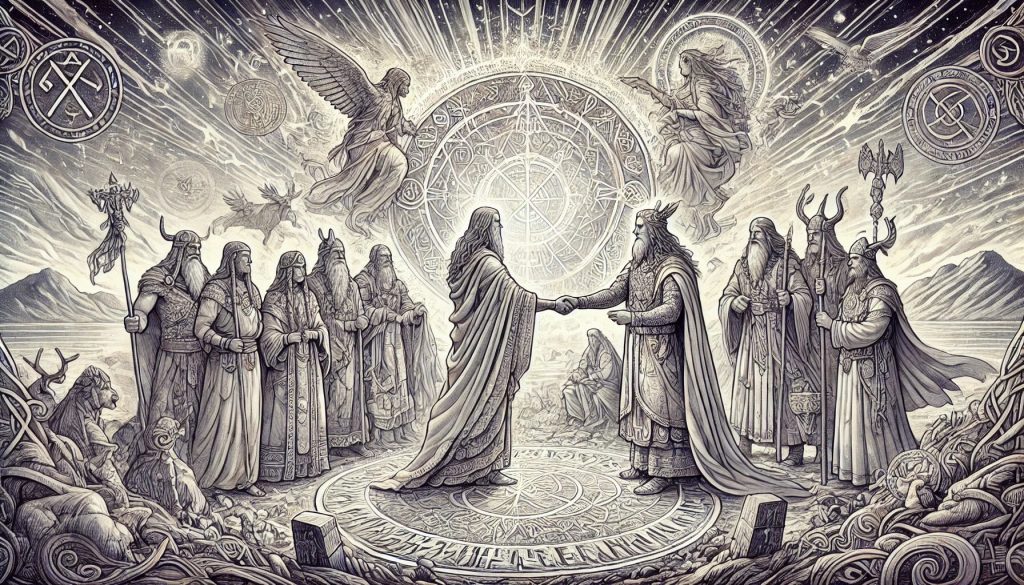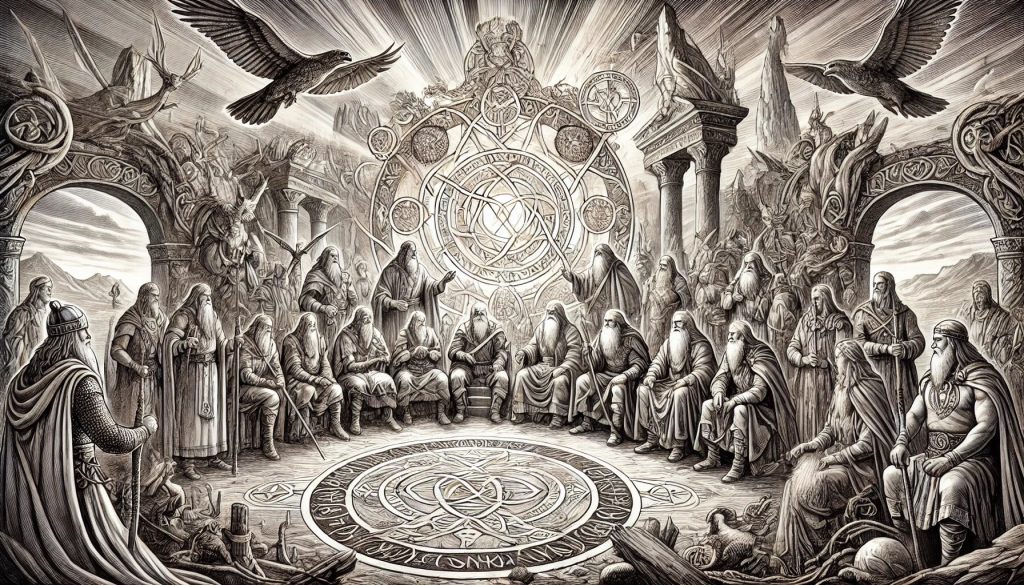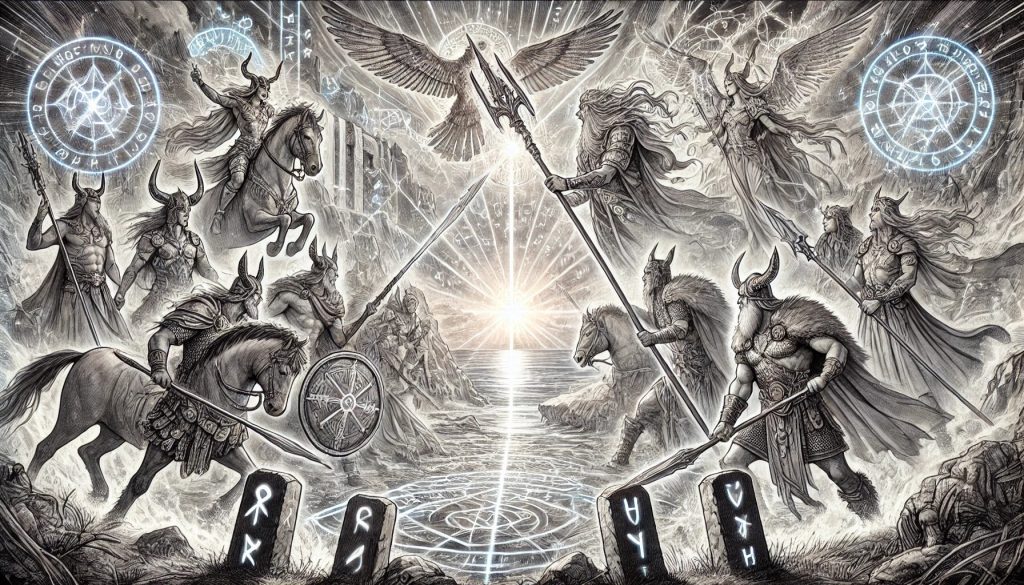Aesir Goddesses, Aesir Gods, Freya, Freyr, Gullveig, Hoenir, Kvasir, Mimir, Njord, Norse Goddesses, Norse Gods, Norse Mythology, Odin, Tales of the Gods, Thor, Vanir Goddesses, Vanir Gods
The Aesir-Vanir War
The Aesir-Vanir War is a legendary story in Norse mythology. It tells of a deep conflict between two groups of gods: the Aesir and the Vanir. This war started from a long rivalry and a desire for power. It led to many battles and events that changed the Norse gods’ world.
The Aesir are known for their bravery and leadership. They faced off against the Vanir, who were deeply connected to nature and fertility. These two groups, each with their own strengths, fought in a big struggle that shook the heavens.
The Aesir-Vanir War is a story about gods fighting in a magical world. It’s filled with epic battles and magical scenes but teaches us about power, loyalty, and finding peace.
After the fighting stopped, the Aesir and Vanir made peace. This peace showed the power of diplomacy and shared values. The agreement brought unity from the conflict, changing Norse mythology forever.
The Aesir-Vanir War is a key event in Norse mythology. It has left a lasting impact on its followers. It teaches us that family ties and seeking peace can win even in chaos. This story shows the bravery of the gods in history.
Introduction to Norse Mythology
Norse mythology is a captivating belief system filled with ancient legends and gods. At its heart is Asgard, a divine realm where gods live and amazing stories happen. The Aesir and Vanir tribes of gods are key players in this mystical world.
Norse mythology celebrates the power and wisdom of Asgard’s gods and goddesses. Odin, the chief god, symbolizes wisdom and knowledge. Frigg, the goddess of fertility, adds grace to the divine world.
The Aesir and Vanir tribes of gods have their own traits and areas of influence, and many stories are told about them in the Edda. The Aesir, linked to war and the sky, rule Asgard. They are led by Odin and Frigg, who rule over love and fertility. The Vanir focuses on fertility and magic. Freyr, their leader, is linked to nature’s abundance.
Other characters, such as those found in the Edda, add depth to Norse mythology. Mimir, a wise god, advises the Aesir. He guards the well of wisdom under Yggdrasil, the world tree.
Norse mythology’s stories are both beautiful and complex. They entertain and teach us about human life and the world’s forces. From Odin’s battles to Freya’s magic, each story is full of symbolism.
Exploring Norse mythology reveals its deep stories and conflicts. The Æsir-Vanir war is a key event, often referred to as the Great War, in which a truce was eventually established. It leads to dramatic battles and a final peace between the tribes.
The Aesir and the Vanir: Two Tribes of Gods
In Norse mythology, the Aesir and the Vanir are two distinct tribes of gods. Each has its own unique traits and areas of influence. The Aesir are known for their roles in war, wisdom, and ruling Asgard. They are one of the two main groups in Norse mythology, along with the Vanir, and are prominently featured in the Edda.
The Aesir gods are known for their bravery and strength. They are linked to battle, victory, and kingship. Odin, the Allfather, and Thor, the god of thunder, lead them. These gods are celebrated for their bravery in war.
The Vanir gods, including the Vanir goddess Freya, live in Vanaheim and focus on fertility, nature, and the earth’s bounty. They are seen as vital and peaceful. They manage crop growth, the seasons, and the balance between humans and nature. Freyr, the god of fertility, and Freyja, the goddess of love and beauty, are key figures in this tribe.
At first, the Aesir and Vanir lived in peace, respecting each other’s strengths. However, their differences led to the Aesir-Vanir war.
This war was a clash of powers and beliefs between the Aesir and Vanir gods. It highlighted the Aesir’s focus on war and wisdom versus the Vanir’s focus on fertility and nature. The war showed that these groups couldn’t agree on their different areas of influence.
Causes of the Aesir-Vanir War
In Norse mythology, the Aesir-Vanir war was a major conflict. It changed the balance of power among the gods. The war started between the Aesir and Vanir gods for many reasons.
Gullveig, a Vanir goddess, was a key factor in starting the war. Her magical powers made the Aesir uneasy, and they saw her as a threat to their rule.

The Aesir wanted the Vanir’s wisdom and magic. They were a tribe of gods linked to war and ruling. They aimed to use the Vanir’s knowledge and control over nature to their advantage.
The war was also about different values and beliefs, similar to the accounts written by Snorri Sturluson. The Aesir valued strength and fighting, while the Vanir focused on nature and fertility. These differences led to a deep conflict.
The murder of Kvasir, a being from both tribes, added to the tensions. Kvasir was born from the gods’ saliva, showing their unity. His death sparked violence and revenge, pushing the tribes apart.
The causes of the Aesir-Vanir war are complex. They involve divine politics, envy, and a quest for power. These factors led to a major conflict that changed Norse mythology forever.
The Outbreak of War
In Norse mythology, the Aesir-Vanir war was a big fight between two groups of gods. It started with the Aesir wanting to take a Vanir goddess named Gullveig hostage. This led to a big battle for who would be in charge.
When the Vanir learned of the Aesir’s plan, they saw it as a serious threat. They decided to attack Gullveig, starting a war between the two groups.
The war was filled with intense battles that changed Norse mythology. Both sides fought hard to protect their honor and power. This war spread, with gods and goddesses joining either the Aesir or the Vanir.
During the war, the Aesir and Vanir used their godly powers to try to win. Their fight showed how strong and smart they were. This war changed Norse mythology, affecting stories and legends for a long time.
Key Battles and Events
The Aesir-Vanir War was a time of great turmoil. It was filled with fierce battles and important events, which changed the war’s story and greatly impacted the gods and their worlds.
The Battle of Hoenir and Mimir was a key fight. It happened when the Vanir felt the Aesir had tricked them into a hostage swap. This battle showed the strength of both sides and made the conflict worse.
Then, there was the Battle of the Wisest. Here, Odin and Mimir, a wise Vanir, fought over who was the wisest. Snorri Sturluson chronicled this battle, which showed the gods’ smart tactics and how important wisdom was in the war.
The Battle of the Cauldron was another big event. Both sides wanted the magical cauldron that could bring back dead warriors. This fight showed how much the gods wanted power and life.
During these battles, the gods used their skills and magic. The Aesir and Vanir showed their strength and what they were willing to do.
Every battle and event was important for the war. They tested the gods’ bravery, loyalty, and intelligence, which was key in deciding who would win the Aesir-Vanir war.
The battles in Norse mythology are very interesting. They show us the complex relationships between gods and the high risks they took. The Aesir-Vanir war and its battles are still remembered in Norse stories, changing the tales of the gods forever.
The Role of Magic and Seidr
Magic and seidr were key in the Aesir-Vanir war, demonstrating their power and importance in Norse mythology. Seidr was a type of magic used for prophecy, sorcery, and controlling fate. Both the Aesir and the Vanir used it in the war.
With seidr, the gods could change outcomes and get ahead in battle. This magical art helped them see the future, cast spells, and guide the war’s course.
In Norse stories, the war shows how magic and seidr linked the supernatural with the mortal world. It shows that these magical practices were not just for the gods. They were a big part of their world.
Both sides used magic and seidr in the war, which shows how important these abilities were in the conflict. Magic was not just for one tribe; it was a shared tool that affected the war.
The Aesir-Vanir war proves magic’s big role in Norse mythology. It shows how magic changed the gods and their actions. It highlights the complex mix of power, destiny, and magic in Norse legends.
The Peace Agreement
After a long and hard war, the Aesir and the Vanir made peace. The Aesir-Vanir War caused a lot of damage and loss. Both sides fought hard across the realms. But they wanted peace and saw fighting as pointless.

The leaders of both tribes worked out the peace agreement. They wanted to stop the fighting and make a lasting peace. This was a big moment for the Norse gods and how they would relate to each other in the future.
Part of the deal was exchanging hostages. This showed trust and a real wish to make up. Hostages from both sides were given to show good faith, helping the Aesir and Vanir understand and work together better.
This peace agreement changed things in the Aesir-Vanir war. It showed that both sides were ready to put aside their differences. They realized that fighting more would only cause more harm.
With the peace agreement, the two tribes started working together. This began a new time of cooperation and respect. The gods saw this as a chance to grow and learn from each other, making strong bonds that would shape Norse mythology.
The aesir-vanir war tested both tribes a lot, but it also led to change. The peace agreement ended the fighting and opened up a brighter future for the gods and their worlds.
Exchange of Hostages
The Aesir and Vanir tribes ended their war with an exchange of hostages, establishing a truce. This move was a key moment in Norse mythology, strengthening the peace between the Aesir and Vanir.
The Aesir Hostages:
- Njord: A wise and kind god, Njord was the god of the sea and wind. His love for the ocean made him a great choice for the Aesir.
- Freya: Freya was the goddess of love, beauty, and fertility. She showed the Aesir’s dedication to peace.
- Freyr: Freyr was the god of fertility and plenty. Being part of the hostage exchange showed the Aesir’s readiness to share with the Vanir.
The Vanir Hostages:
- Hoenir: Hoenir was wise and a leader. He stood for justice and knowledge in the Vanir tribe. His stay in Asgard meant the Vanir had a say in Aesir’s decisions.
- Mimir: Mimir guarded knowledge and wisdom. He showed Vanir’s dedication to truth and learning. His wisdom helped both tribes grow together.
This hostage exchange showed trust and teamwork between the Aesir and Vanir, leading to the eventual truce. It was a clear sign of their wish for peace and unity. This move led to a new chapter of working together in Norse mythology.
The Aftermath and Integration of the Two Tribes
After the Aesir-Vanir war, a big change came. The Aesir and Vanir tribes came together. This brought the gods of both sides into unity and harmony. It made the pantheon stronger and helped them understand their powers better, especially among the Æsir.
The end of the war was a key moment for the gods. They put aside their differences and worked together. They saw how their strengths could help each other. This led to a big change in the divine world, strengthening the pantheon.
The Aesir and Vanir tribes merged their powers and domains. This mix made a balanced sharing of tasks and a deeper understanding of the divine. The gods worked together smoothly, managing the cosmos with great unity.
Bringing the tribes together wasn’t easy. The gods had to adjust and face challenges. But they stayed focused on unity and a shared goal. This kept their bond strong and ensured that Aesir and Vanir stayed together.
The aftermath of the Aesir-Vanir war and the tribes’ integration shows how conflict can lead to change. It brought the gods together and taught a lesson to all. By accepting differences and working together, amazing things can be done, and peace can spread.
Significance of the Aesir-Vanir War in Norse Mythology
In Norse mythology, the Aesir-Vanir war is a key event. It shows a critical moment in the gods’ world. This war between the Aesir and Vanir gods reveals the complex nature of their world.
The war’s importance comes from its deep themes in Norse stories. It shows the fight for power, as the Aesir wanted to rule over the Vanir. This fight highlights how power and rank are crucial in the gods’ world.

It also shows the need for working together and finding balance. Even though the Aesir and Vanir were different, they made peace. They realized they needed to work together to keep the world stable.
Moreover, the war explains how different gods became part of the Norse pantheon. After making peace, gods from both sides became part of each other’s group. This shows how the gods are connected and work together.
The Aesir-Vanir war is very important in Norse stories. It talks about power, fighting, working together, and finding balance. By exploring these stories, we learn more about the rich myths and legends of Norse beliefs.
Themes and Lessons from the Tale
The Aesir-Vanir War is a deep dive into mythology and symbolism. It shows themes and lessons that last beyond time and culture. This epic battle is not just about gods fighting. It also examines human nature, the dangers of greed, and the harm caused by aggression.
At the heart of the Aesir-Vanir war is the search for peace and finding common ground. It acts as a mirror to the conflicts we see in our world. It encourages us to look for peaceful ways to solve problems, often hoping for a truce instead of fighting.
The war also teaches us about the strength of unity. The Aesir and Vanir tribes were once enemies but learned to work together. This shows us that we can overcome big challenges and build a stronger community by joining forces and understanding each other.
This war also warns us about the dangers of wanting too much power and being too aggressive. The gods’ endless desire for power led to great harm. This lesson tells us to keep our goals in check and think about the future effects of our actions.
The symbolism in the Aesir-Vanir war also discusses the power and who’s in charge. It shows how being too full of ourselves and the corrupting influence of power can be dangerous. It tells us to stay humble and fair, especially when we have a lot of power.
In the end, the Aesir-Vanir war gives us lessons on being human and how we interact with each other. It teaches us about solving conflicts, working together, and understanding others. It also warns us about the risks of wanting too much and being too aggressive, a theme Snorri Sturluson often explored. By understanding these lessons, we can learn more about ourselves and our role in the world.
Conclusion
The Aesir-Vanir war is a key story in Norse mythology. It tells of the conflict and then the unity of the Aesir and Vanir gods. This war shows us power struggles, the importance of magic, and the value of unity.
This story teaches us about human nature and the complex relationships between gods. It shows how power and pride can lead to war. But it also shows how working together can lead to peace.
The start of the war and its battles show us the harm of fighting. They remind us to seek peace instead. This story teaches us to value cooperation over conflict.
The war also discusses magic and seidr. It shows how magic can be used for good or bad. As noted in the Edda, magic can help or hurt, depending on how it’s used.
In the end, the war ends with peace and hostages being exchanged. This shows how the Aesir and Vanir gods came together. It’s a lesson in forgiveness and finding common ground.

